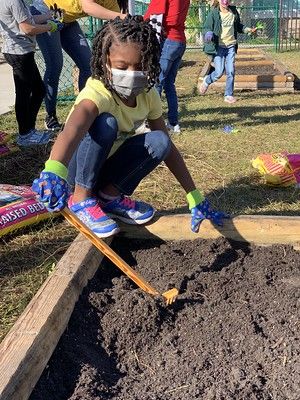

Second Grade Gardeners
Source/Author: Michele Johnson, Second Grade Teacher
May 28, 2021
Since January, second graders have been reviving the Lower School campus garden. Students selected plants, designed and planted the gardens, and were responsible for the upkeep of the space.
The Chargers started by heavy digging, weeding and clearing out the space. The layout of the space tied in with their math lessons on arrays, using rows and columns. Students learned about the shapes, colors, and types of flowers preferred by two specific pollinators: bees and butterflies. For a while there was a netted structure to cover the new garden beds to keep each egg, caterpillar, and chrysalis safe. Unfortunately, the structure was no match for Florida rain storms. Without the structure, wasps began to prey on the caterpillars, and the milkweed that the caterpillars eat was attacked by aphids. Aphid control became a priority, as they suck the moisture and nutrients from the milkweed and eventually cause the plants to die.
In the classroom, students planted milkweed seeds in order to start their own seedlings (caterpillars really are very hungry, just like the book says!) and observed painted lady butterflies as they moved through the various stages of their life cycle. The painted ladies arrived as larva and grew into larger caterpillars before wrapping up into their chrysalis stage. Monarch caterpillars of varying sizes were also brought in from home gardens so students could look closely at caterpillar anatomy. Student observations included labeled sketches, written observations detailing day to day changes, and comparisons between the painted ladies and monarchs. And then, the moment every student had been waiting for arrived… the painted ladies emerged from their chrysalises!
Second graders would like to thank everyone who helped weed and hydrate the garden, with a special shout out to Lower School Spanish Teacher Señora Verastegui. Thank you also to Shorecrest parent Leslie Mathews for providing supplies throughout the semester, including the butterfly garden structure, soil, and native plants. The children were able to finish the year by releasing the butterflies into the pollinator garden. What a fitting way to wrap up second grade and head into the summer!
You might be wondering - why a pollinator garden? The statistics are fascinating. Over one third of our nutrient rich crops depend on pollinators, yet our daily actions are directly impacting these populations to the point of rapid decline. The young Chargers made it their goal to create a pollinator-friendly garden and give these amazing insects space on the Shorecrest campus. More pollinators will result in more crop production, which will help our global fight against food insecurity. In short, our lives depend on pollinators.
Find more gardening photos here.
Find more gardening photos here.
























